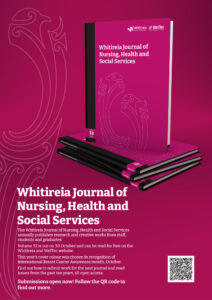 Since 1994, the journal has published research, creative works and reflections from kaimahi and ākonga from Whitireia and WelTec, as well as other tertiary education institutions, allied service providers and the health industry. This year marks the release of volume 32, which will be available via open access and will be free of charge.
Since 1994, the journal has published research, creative works and reflections from kaimahi and ākonga from Whitireia and WelTec, as well as other tertiary education institutions, allied service providers and the health industry. This year marks the release of volume 32, which will be available via open access and will be free of charge.
This edition opens with an editorial by Associate Professor Kathy Holloway (Victoria University), Building on Our Strengths: Growing a Sustainable Healthcare Workforce for Aotearoa, in which she explores the reasons that the long-term stability of the national health workforce remains uncertain. She concludes with three suggestions to support the development of a more sustainable nursing and paramedic workforce.
In Reflections on Tohu Iwi Kuinga Rōpū: Decolonising a Well Child Tamariki Ora Postgraduate Nursing Programme, Gay Ford, Wanetta Sayer and Jess Beauchamp (Whānau Āwhina Plunket) detail how one postgraduate nursing programme was not meeting the needs of its Māori nurse ākonga. Tohu Iwi Kuinga, an additional teaching stream for those who whakapapa Māori and work with iwi providers and organisations, was developed with these groups. The researchers reflect on further suggestions for how the postgraduate certificate and Tohu Iwi Kuinga can be developed to further decolonise teaching and learning.
The next research article is Stress, Resilience, and Student Nurses: Piloting a Mindfulness-based Intervention by Tara Malone (Western Institute of Technology at Taranaki). Malone reports that nursing ākonga experience high levels of stress during study, which may impact their mental health and retention rates. She undertook a pilot mixed-method study, where mindfulness was introduced as an intervention to potentially increase resilience and reduce stress, with initial results indicating that the intervention was successful.
In Simulation-based Learning in Social Work Education, Ashleigh Price and Shelley Winters (Whitireia and WelTec) discuss a pilot research project exploring how effective and beneficial simulation, a teaching modality typically employed in health education, may be in social work education.
In Does Using Hermeneutic Phenomenology Truly Aid in Understanding a Phenomenon? Karyn Madden (Southern Institute of Technology) explores ākonga perspectives on mixed reality simulation (the combination of physical exchanges and virtual reality). To do so, she adopts a hermeneutic phenomenological approach, which provides in-depth understandings of ākonga experiences. She maintains therefore, that such an approach would be beneficial to include in nursing education and research generally.
In Unpacking Deviance During the COVID-19 Pandemic: Reflections from a Personal and Sociological Perspective, Dr Rachel Tallon (Whitireia and WelTec) ponders the reasons why some people refused to adhere with Government-directed mandatory vaccines during the 2020 and 2021 national COVID-19 related lockdowns. Although these people were looked at with derision at the time, she explores many potential reasons for their abstaining, which she links to sociological theory.
In the final research article, The Gender Participation Gap: Barriers to Physical Activity for Females Aged 17–25: A Student Cohort in Taranaki, New Zealand, Tessa Nielsen, Kieran McKendry and Dr Steve Scott (Western Institute of Technology at Taranaki) explore the reasons why young women do not participate in physical exercise and sport to the same extent as their male counterparts.
The Whitireia Journal of Nursing, Health and Social Services is published annually. Articles for inclusion in the 2026 can be sent to: https://www.whitireiaweltec.ac.nz/about-us/research/whitireia-journal-of-nursing-health-and-social-services
Any questions, please contact [email protected].
Catherine Fuller,
programme coordinator postgraduate certificate
in nursing (mental health), Whitireia
Lee Smith,
senior research advisor, Whitireia



